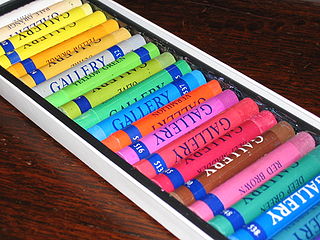
Portable Network Graphics is a raster-graphics file format that supports lossless data compression. PNG was developed as an improved, non-patented replacement for Graphics Interchange Format (GIF)—unofficially, the initials PNG stood for the recursive acronym "PNG's not GIF".

In color theory, hue is one of the main properties of a color, defined technically in the CIECAM02 model as "the degree to which a stimulus can be described as similar to or different from stimuli that are described as red, orange, yellow, green, blue, violet," within certain theories of color vision.

The Enhanced Graphics Adapter (EGA) is an IBM PC graphics adapter and de facto computer display standard from 1984 that superseded the CGA standard introduced with the original IBM PC, and was itself superseded by the VGA standard in 1987. In addition to the original EGA card manufactured by IBM, many compatible third-party cards were manufactured, and EGA graphics modes continued to be supported by VGA and later standards.

The Super Game Boy is a peripheral that allows Game Boy cartridges to be played on a Super Nintendo Entertainment System console. Released in June 1994, it retailed for $59.99 in the United States and £49.99 in the United Kingdom. In South Korea, it is called the Super Mini Comboy and was distributed by Hyundai Electronics. A revised model, the Super Game Boy 2, was released in Japan in January 1998.

A choropleth map is a type of statistical thematic map that uses pseudocolor, meaning color corresponding with an aggregate summary of a geographic characteristic within spatial enumeration units, such as population density or per-capita income.
In color theory, a color scheme is a combination of 2 or more colors used in aesthetic or practical design. Aesthetic color schemes are used to create style and appeal. Colors that create a harmonious feeling when viewed together are often used together in aesthetic color schemes. Practical color schemes are used to inhibit or facilitate color tasks, such as camouflage color schemes or high visibility color schemes. Qualitative and quantitative color schemes are used to encode unordered categorical data and ordered data, respectively. Color schemes are often described in terms of logical combinations of colors on a color wheel or within a color space.
Microsoft Video 1 or MS-CRAM is an early lossy video compression and decompression algorithm (codec) that was released with version 1.0 of Microsoft's Video for Windows in November 1992. It is based on MotiVE, a vector quantization codec which Microsoft licensed from Media Vision. In 1993, Media Vision marketed the Pro Movie Spectrum, an ISA board that captured video in both raw and MSV1 formats.

In cartographic design, map coloring is the act of choosing colors as a form of map symbol to be used on a map.

In computer graphics, color quantization or color image quantization is quantization applied to color spaces; it is a process that reduces the number of distinct colors used in an image, usually with the intention that the new image should be as visually similar as possible to the original image. Computer algorithms to perform color quantization on bitmaps have been studied since the 1970s. Color quantization is critical for displaying images with many colors on devices that can only display a limited number of colors, usually due to memory limitations, and enables efficient compression of certain types of images.

A color picker is a graphical user interface widget, usually found within graphics software or online, used to select colors and, in some cases, to create color schemes. Operating systems such as Microsoft Windows or macOS have a system color picker, which can be used by third-party programs.

Workbench is the desktop environment and graphical file manager of AmigaOS developed by Commodore International for their Amiga line of computers. Workbench provides the user with a graphical interface to work with file systems and launch applications. It uses a workbench metaphor for representing file system organisation.
Vehicle registration plates in Luxembourg bear a maximum of six characters. The standard series in use today uses a format of two letters followed by four digits. Before adoption of the current scheme, marks consisting only of digits and two digits and three numbers letters, were issued. The digit-only plates may only now be issued as a custom plate.

In color science, a color gradient specifies a range of position-dependent colors, usually used to fill a region.
Cynthia Ann Brewer is an American cartographer, author, and professor of geography at Pennsylvania State University. Brewer's specialty relates to visibility and color theory in cartography. In 2023, she was awarded the International Cartographic Society's highest honor, the Carl Mannerfelt Gold Medal, for her distinguished contribution to the field.

The Chevrolet Corvette (C7) is the seventh generation of the Corvette sports car manufactured by American automobile manufacturer Chevrolet from 2014 until 2019. The first C7 Corvettes were delivered in the third quarter of 2013. The racing variants include the C7.R, which won the GTLM 24 Hours of Le Mans.

Pastels or pastel colors belong to a pale family of colors, which, when described in the HSV color space, have high value and low saturation. They are named after an artistic medium made from pigment and solid binding agents, similar to crayons. Pastel sticks historically tended to have lower saturation than paints of the same pigment, hence the name of this color family. The popularity of pastel colors has evolved over time, with notable periods of prominence in various historical and cultural contexts. A significant era that saw a surge in the popularity of pastel colors was the late 19th century, particularly during the Victorian era.
Apple Video is a lossy video compression and decompression algorithm (codec) developed by Apple Inc. and first released as part of QuickTime 1.0 in 1991. The codec is also known as QuickTime Video, by its FourCC RPZA and the name Road Pizza. When used in the AVI container, the FourCC AZPR is also used.
QuickTime Graphics is a lossy video compression and decompression algorithm (codec) developed by Apple Inc. and first released as part of QuickTime 1.x in the early 1990s. The codec is also known by the name Apple Graphics and its FourCC SMC. The codec operates on 8-bit palettized RGB data. The bit-stream format of QuickTime Graphics has been reverse-engineered and a decoder has been implemented in the projects XAnim and libavcodec.

HCL (Hue-Chroma-Luminance) or LCh refers to any of the many cylindrical color space models that are designed to accord with human perception of color with the three parameters. Lch has been adopted by information visualization practitioners to present data without the bias implicit in using varying saturation. They are, in general, designed to have characteristics of both cylindrical translations of the RGB color space, such as HSL and HSV, and the L*a*b* color space. Some conflicting definitions of the terms are:

Warming stripes are data visualization graphics that use a series of coloured stripes chronologically ordered to visually portray long-term temperature trends. Warming stripes reflect a "minimalist" style, conceived to use colour alone to avoid technical distractions to intuitively convey global warming trends to non-scientists.
















